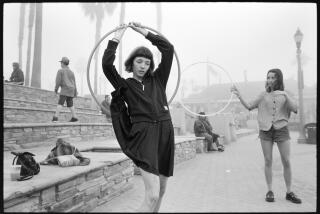A Camera That’s Worth a Thousand Words
In almost every American home, there’s a shoe box or album with some grainy snapshots tucked inside--small square prints, somewhat faded, often of people you don’t know wearing odd-looking clothes.
Many of those photos were taken with a Brownie, the inexpensive box-like camera introduced by Kodak 100 years ago that changed photography--and the way we archive our lives--forever.
No longer did successive generations rely on Aunt Minnie’s diaries to remember who wore what at whose wedding or granddad’s sketches to know just what the family homestead looked like after a tough winter. They just took a picture.
George Eastman, founder of Eastman Kodak Co., “was going after the masses . . . ,” said Kathy Connor, curator at the Eastman House, International Museum of Photography and Film in Rochester, N.Y. “He felt that the normal person wouldn’t be as critical of the quality of the film [and equipment] as a professional.”
And Eastman was right.
Camera dealers didn’t want to sell Brownies because there was little profit in them, and professional photographers regarded the cardboard cameras much like portrait artists see finger paints. But consumers loved them--once Kodak created the demand for affordable at-home photography, that is.
That’s how the Brownie got its name.
“In the 1890s and early 1900s, the craze was the Brownie [cartoon] characters, sort of like Pokemon today,” Connor said. “You would have to have been a cultural moron not to know what a Brownie was.” The character, drawn by Canadian illustrator Palmer Cox, was used to sell everything from stamps, glue and coffee to nails, kids’ products and, finally, box cameras.
Therese Mulligan, curator of photography at the George Eastman House, said Eastman’s strongest suit was marketing.
“That element of play is a part--a major part--of the language of the kind of advertising he used for the Brownie,” she said. “Polaroid has learned from Kodak in that way. Today, the most popular camera is a snapshot Polaroid--the I-Zone.”
Like all Polaroid images, these come out of the camera fully developed, but they are small and adhere to any surface easily.
“The picture is nothing. It’s about play,” Mulligan said.
“It’s the only artistic medium where you get instant results. It’s hard to take brushes, an easel and a canvas and make it look like something,” said Stan Tamarkin, a New York and Connecticut camera dealer and auctioneer. “You can do that almost immediately with a camera.”
The fun of creating an image with a Brownie led many a child to become a serious photographer, hobbyist or camera collector.
Chuck Baker, founder of the Brownie Camera Page on the Internet, tells a tale familiar to many photographers:
” . . . When I was about 8 or so, I remember finding a box with a Brownie developing kit that my mom and dad had once purchased and then laid to rest in our attic. I remember already having an interest in photography then, so finding it was really great!
“That started my real photography interest,” said Baker, whose site is https://members.aol.com/chuck02178/brownie.htm.
Baker created the site five years ago, when he found very little information on the Internet.
“I was looking for Brownies on the Web because I had started shooting with Brownies and Box, pinhole and toy Holga cameras for my artwork along with my ‘good’ cameras,” he said.
In photography, as in fashion, everything comes back in style eventually.
